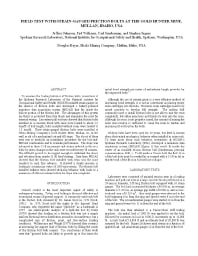Mining Publication: Field Test with Strain-Gauged Friction Bolts at the Gold Hunter Mine, Mullan, Idaho, USA
Original creation date: August 2003
Authors: JC Johnson, TJ Williams, CB Sunderman, SP Signer, DC Bayer
NIOSHTIC2 Number: 20030805
In: S. S. Peng, C. Mark, A. Wahab Khair, and K. Heasley, eds., Proceedings: 22nd International Conference on Ground Control in Mining (Aug. 5-7, 2003; Morgantown WV), Dept. of Mining Engineering, West Virginia University, 2003 Aug; :233-239
To measure the loading behavior of friction bolts, NIOSH researchers installed strain gauges on the interior of friction bolts and developed a battery-powered miniature data acquisition system (MIDAS) that fits inside the hollow portion of the friction bolt. The advantages of this system are that it is protected from face blasts and eliminates the need for external wiring. Laboratory pull-out tests showed that friction bolts installed in a concrete block with resin were loaded to about 1.8 tons/ft of bolt length; bolts installed without resin were loaded to 1.3 tons/ft. Three strain-gauged friction bolts were installed at Hecla Mining Company's Gold Hunter Mine, Mullan, ID, in the wall or rib of a mechanized cut-and-fill stope. The object of these tests was to establish an installation procedure for the bolt-and-MIDAS combination and to evaluate performance. The stope was advanced in three 15-ft increments and strains induced in the rock bolts by stress changes in the rock were recorded every 30 minutes. The MIDAS proved to be rugged enough to withstand the shock and vibration from nearby (5 ft) face blasting. Data from MIDAS showed that the friction bolt installed with resin was the most sensitive to each face advance. It showed a steady increase in loading to a maximum value of 1000 microstrain. The friction bolt installed without resin showed stick-slip behavior with loads to a maximum of 400 microstrain before the stope was completed.

NIOSHTIC2 Number: 20030805
In: S. S. Peng, C. Mark, A. Wahab Khair, and K. Heasley, eds., Proceedings: 22nd International Conference on Ground Control in Mining (Aug. 5-7, 2003; Morgantown WV), Dept. of Mining Engineering, West Virginia University, 2003 Aug; :233-239
- 60 Years of Rockbursting in the Coeur D'Alene District of Northern Idaho, USA: Lessons Learned and Remaining Issues
- A Case Study of Bolt Performance in a Two-entry Gate Road
- Geomechanics of Reinforced Cemented Backfill in an Underhand Stope at the Lucky Friday Mine, Mullan, Idaho
- Geophysical Methods to Detect Stress in Underground Mines
- In Situ Stress at the Lucky Friday Mine (In Four Parts): 2. Analysis of Overcore Measurement From 5300 Level
- In Situ Stress at the Lucky Friday Mine (In Four Parts): 3. Reanalysis of Overcore Measurements from the Star Mine
- In Situ Stress at the Lucky Friday Mine (In Four Parts): 4. Characterization of Mine In Situ Stress Field
- Investigation of a Rock-Burst Site, Sunshine Mine, Kellogg, Idaho
- New Tricks for an Old Elephant: Revising Concepts of Coeur d'Alene Geology